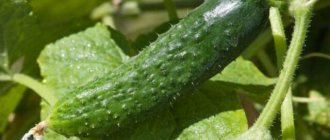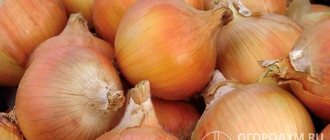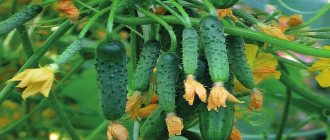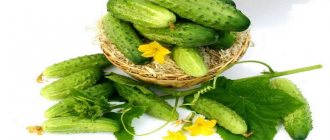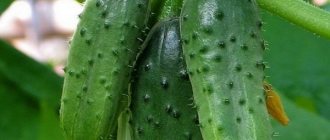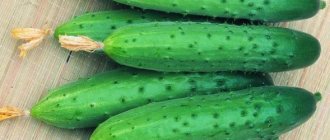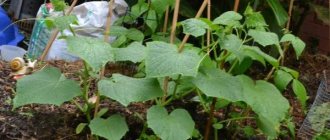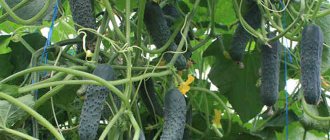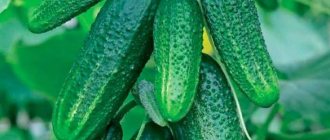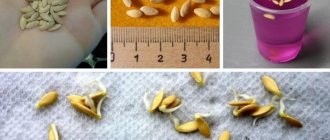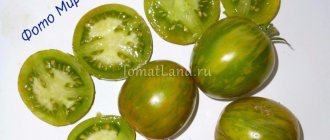Cucumber Merry Dwarfs F1 is one of the hybrid cultivars whose popularity is increasing every year. Their taste is not inferior to varietal ones, but the yield, endurance and disease resistance are much higher.
| Landing location | Ripening time | Mode of application | Fruit length | Group | Fruit smoothness | Pollination method |
| Universal | Early ripening (35-45 days) | Universal | Short (gherkins) - less than 10 cm | Hybrid | Slightly lumpy | Parthenocarpic |
Firm-
conducts active breeding work at the global level. It is better to purchase branded packaging. All modern Gavrishevsky cucumbers are not bitter. Thanks to targeted selection, each hybrid has its own characteristic features, “its own face.”
Cucumber Goosebumps F1
A rare feature for self-pollinating cucumbers is the black spines. This is a trademark of high quality conservation products. The fruits have a beautiful presentation - dark, dense, with evenly spaced medium-sized tubercles, elegant. Weight 95 grams, length 12 cm. The bushes are powerful, with dense leaves, an average degree of branching, and produce a yield of 7 kg. A bunch of ovaries up to 6 pieces. From the appearance of sprouts to the first harvest, 43-45 days pass. The hybrid is resistant to root rot and olive blotch
Downy mildew with powdery mildew does not spoil him (fortunately) with attention either. On the register since 2003
Cucumber Courage F1
The high cost of Kurazh cucumber seeds pays off with an excellent harvest - a bucket from a bush. The self-pollinating plant is capable of simultaneously growing two dozen fruits. If you carry out pinching (remove side branches), then from each axil of the main stem, not the usual 3-5 ovaries grow, but 10-12 pieces. The central lash is long. It quickly (from 40 days) enters long-term fruiting. The length of the harvested fruits - with dense pulp and a weight of about 110-115 grams - fluctuates about 12 cm. The tubercles are medium-sized, rather densely seated, white-pubescent. The hybrid is not susceptible to viruses, cladosporiosis, powdery mildew and downy mildew. The year of registration in the register is 2002.
Cucumber Emerald earrings F1
The newest (2011) self-pollinating cucumber with a powerful branched bush and numerous bouquet ovaries - up to 10 per node with decent nutrition and good lighting. Harvesting is possible at the pickle and gherkin stage. Limit dimensions - 11 cm, 110 grams. The spines are light, rather densely located. The hybrid is resistant to all cucumber diseases. It begins to give greens on the 42nd day, amicably, for a long time.
Cucumber Mother-in-law F1
Contrary to popular belief, it differs significantly from the “paired” hybrid Zyatek. Included in the register in the same year, Mother-in-law has a more delicate taste (Zyatek is harsher), a strong aroma, and has brown thorns. The plant begins to bear fruit, unlike its “relative,” 4-7 days later, with 3-4 greens per node. The return of the greenies is extended. Resistance to infections is excellent.
Cucumber Berendey F1
The main feature is the ability of vegetables to bear fruit in the shade, which, combined with parthenocarpy and resistance to root rot, makes it possible to harvest even in an apartment. In greenhouses, cucumbers also perform well, producing buckets of fruit from the bush. As a rule, 3-4 ovaries are tied in knots. The size of the greens is 14 cm, 135 grams. They are white-haired, with beautiful tubercles. The purpose is primarily salad, although the hybrid is also suitable for pickling. In terms of timing, medium early (44-50 days). Registered in the register in 2007.
Cucumber Garland F1
A newer version (2010) of a shade-tolerant self-pollinating hybrid with the highest resistance to all cucumber diseases. Cultivated indoors, greenhouses; It can also be done outdoors. The main lash is long, the branching is very weak. Bouquet ovary - 4-5 pieces. The greens are dark, tuberculate, with light pubescence, dense, fragrant. Grows up to 13 cm, 125 grams. The purpose is universal.
Cucumber Zyatek F1
The most popular parthenocarpic for collecting pickles, gherkins, traditional greens (11 cm, 95 grams). The taste is excellent. The cucumber tubercles are quite dense, beautiful, and white-pubescent. Each node grows from 2 to 8 greens. Vegetable productivity is high. Fruits from 45 (plus or minus 3) days from the appearance of sprouts and for a long time. Does not suffer from powdery mildew (both downy and real), root rot. My recommendations for growing it both in a greenhouse and in open ground. On the register since 2007.
Cucumber Break F1
This self-pollinating cucumber hybrid has been on the register since 2002. It is recommended for greenhouse crops, but also gave excellent results in open ground. Medium-sized, medium-branched. On the main stem it forms two or three ovaries in the axil of each leaf, and up to 8 on the branches. The bush gives a bucketful harvest. This is greatly facilitated by resistance to the most harmful infections - downy mildew, powdery mildew, and root rot. Zelentsy are 10 cm in size, 90 grams, excellent for preservation. They are often tuberculate, with light spines of medium size.
"Sweet Sue"
Tomato bred by US breeders. The plant is compact, up to 70 cm high. Medium ripening period.
The tomatoes are light yellow, sometimes tanned slightly pink. Round with an average weight of up to 150 g.
The Sweet Sue tomato has a pleasant, sweet taste and amazing aroma. Those who have already managed to grow the variety compare it to melon.
Reviews indicate that this tomato remains unharmed by diseases under any circumstances. Gardeners consider it the most stable.
Advantages
- Great taste;
- Increased resistance to diseases;
- Undemanding to weather conditions.
Flaws
- Need for fixation;
- Requires high nutritional soil.
Characteristics of the cucumber Merry gnomes F1, cultivation and harvesting
Cucumber Merry Dwarfs F1 belongs to the group of hybrids in which the fruits grow in the form of bouquets similar to bunches of bananas. This variety produces high yields even under unfavorable climatic conditions.
This vegetable can be grown even at home, on a balcony or loggia. But at the same time, the plant’s productivity drops by 20-30%. Fruits can be transported to any distance. You can store Merry Gnomes in a cold room for up to 1.5 months.
Vegetables are consumed fresh and canned for the winter.
Hybrid specifications
The description of the plant is as follows:
- The variety belongs to the group of hybrids with early ripening. The growing season of the plant from the first shoots to fruit lasts about 40 days, regardless of whether cucumbers are grown in open areas or in greenhouse blocks.
- The hybrid does not require pollination by insects. The bushes are about 1.2 m high (in a greenhouse), so they must be tied to trellises. The plant is grown in 1 stem.
- The hybrid requires constant removal of stepsons. Up to 5 fruits develop in the axil of the cucumber. The plant has increased immunity to most diseases.
- The fruits stretch 80-90 mm in length, and their average weight is about 80 g, although many gardeners managed to obtain specimens weighing up to 0.1 kg. On the flower side, the cucumber is colored in light green tones with yellow stripes (they reach the middle of the length of the fruit), and the main body of the vegetable has a dark green color.
- The surface of the vegetable is covered with bumps and white spines, but the skin of the fruit is quite thin, and the flesh is juicy and crispy.
Feedback from farmers shows that Cheerful Gnomes produce a harvest of 5-7 kg from each bush. Fruiting of the hybrid continues until the end of August. Although cucumbers do not outgrow, it is recommended to harvest them in a timely manner; the bush may dry out.
Seedlings are germinated from seeds, allowing them to swell in water (it should be warm). After this, the planting material is laid out on a napkin to dry. After 2 days, 90% of the seeds develop roots.
After this, they can be planted in the ground. Most often, to grow seedlings, the seed fund is sown in separate containers. This happens in early March. The soil is chosen to be loose and fertilized with manure or peat.
If the seeds are sown in plastic cups to a depth of 15-30 mm. When using a common box, a distance of 70 mm is left between individual seeds, and an interval of 20 cm is maintained between rows.
Before the sprouts develop, the container is covered with glass or transparent film. When seedlings appear, the soil is kept slightly moist. Feeding the sprouts with fertilizers begins when 2 leaves appear on them.
When the seedlings are 25-30 days old, they are transplanted to a permanent place. If you plan to plant bushes in open ground, then no more than 3 plants are planted per 1 m², and up to 5 seedlings in a greenhouse.
In regions with cold climates, seedlings are transferred to beds in a greenhouse. This happens in the last ten days of April.
How to care for bushes before fruiting?
Watering is carried out with warm, settled water once every 2 days. Most often, late evening is used for this operation. If there is summer heat, then watering is postponed to early morning. To protect plants from burns, do not allow moisture to get on the leaves. In case of sudden cold weather, the frequency of watering is reduced to 1 time in 5 days.
Bushes are fed with complex fertilizers, alternating them with organic mixtures. It is better to combine fertilizing with watering. The first time the operation is carried out 2 weeks after transplanting the plants onto permanent soil. Then the bushes are fed every 9-10 days. The use of fertilizers cannot be stopped even during fruiting.
When bushes grow, nitrogen fertilizers are used, during flowering they switch to phosphorus, and after the fruits appear, the plants are fed with both phosphorus and nitrogen ingredients. The hybrid must be treated 2 times per season with growth stimulants. First, this is done when the buds open, and then during intensive flowering.
Although Merry Gnomes are disease-resistant, preventative measures should not be neglected. It is recommended to use the drug Fitosporin for this.
The hybrid may be attacked by aphids. To destroy it, it is recommended to use soap or ash solutions. Some gardeners use various herbal infusions or decoctions. If they do not help destroy the insects, then industrially produced poisonous substances made on an organic basis should be used.
Advantages and disadvantages
Gardeners prefer this hybrid for the following reasons:
- Productivity - with sufficient fertilizer and regular watering, you can harvest from 3 kg of cucumbers from a bush.
- Presentation – cucumbers even out in size when ripe; overgrowing and barreling are not typical for the hybrid.
- Size – the fruits are small, which allows them to be used for various preparations.
- Taste – no bitterness, the flesh is dense and juicy.
- Immunity – you don’t have to worry about epidemics.
The cucumber has no obvious disadvantages, but one should take into account the hybrid’s demands on the soil: it must be well prepared and abundantly fertilized with organic compounds. Also, the hybrid origin of the cucumber makes collecting native seeds impossible.
Biological features
The plant belongs to the semi-standard type with a limited growth point. The ripening period is short - 40 days from the germination of seedlings to the first pups. Regardless of the growing conditions, the Jolly Dwarfs bush has the following characteristics:
- powerful fibrous root system;
- the stem is strong, light green, with strong pubescence, 1-1.2 m long;
- leaves are large, spreading with spiny pubescence on the surface;
- small number of side shoots;
- bouquet type flowering;
- lemon-colored female flowers that do not require external pollination.
Gardeners and farmers value the hybrid for its high yield. One compact plant produces a large number of ovaries. This is due to the Bundle type of fruit formation. 4-6 cucumbers are formed from one internode. In one season, the bushes of the Cheerful Gnome produce about 9 kg of marketable fruit. Due to the parthenocarpic type of pollination, the yield of the hybrid does not decrease in closed greenhouses where there is no access for insects.
For information! If you let the growth of a cucumber take its course and do not remove the side shoots, then over time the leaves and fruits will noticeably become smaller. This has a significant impact on yield reduction.
Description of the cucumber variety Cheerful gnomes
The cucumber variety Cheerful Gnomes is of the semi-standard type, grows up to 1.2 m in length. The end point of growth is limited; the cucumber variety produces few side shoots; they do not unload the main stem. The bush is formed with one central shoot, the stepsons are broken off. The Merry Dwarfs cucumber is grown using the trellis method; the plant requires fixation to a support during fruiting.
The cucumber of the Merry Dwarfs variety is characterized by the bouquet formation of flowers. The parthenocarpic hybrid forms an ovary on each flower, and the fruits ripen in bunches. The crop does not require pollinators; the yield in greenhouses and greenhouses is the same. The plant is not tall, suitable for growing on balconies and in apartments on the windowsill. At home, the yield is less, but two bushes of the variety are enough for a family of 4 people.
External description of the cucumber Merry gnomes F1:
- A plant with a limited growing point, the central trunk is light green with a gray tint. The pubescence is weak, the surface is uneven, the fibrous structure is hard. There are a small number of lateral shoots; they are thin, underdeveloped, and a shade darker than the main stem.
- The foliage is medium, the leaves are small, opposite, heart-shaped with large teeth along the edge, on short stalks. The leaf blade is pointed upward, the surface is rough, intensely pubescent with short hair. The color is green on the top of the leaf, the underside is lighter.
- The root system is fibrous, superficial, branched, the root circle is small.
- Lemon-colored flowers, collected in a leaf node, in the form of a bouquet of 3-6 pieces. The plant produces female flowers, ovaries are formed 100%, there are no barren flowers on the plant.
Attention! The hybrid Merry Dwarfs was bred by cross-pollination of varieties, does not contain genetically modified organisms (GMOs), and is allowed for consumption in unlimited quantities.
Characteristic
The plant is slender, tall, with large round leaves of a rich dark green color. Its bush is not very spreading, and the side shoots are not long, which greatly simplifies care. Another advantage is that this variety has fewer leaves than others, which allows the cucumbers to ripen faster.
Description of fruits
The vegetables are dark green with small pimples and have a uniform density. The average size of a cucumber is 9-12 cm (gherkin), the taste is pronounced, the vegetable is not bitter.
Productivity
The variety gives excellent results in terms of fruiting, which makes the yield of Bjorn F1 high. Most cucumbers are placed on the main stem, which makes harvesting the fruit easier. Flowering is of bouquet type - in each axil there are 4-5 ovaries, from which greens then grow.
The bush produces up to 15 kg of fruit per season. Another qualitative characteristic of the variety is that cucumbers do not barrel during the ripening process.
Ripening time
This cucumber variety is early (hybrid sprinter). From the moment the seedlings are placed in the ground until the first fruits appear, approximately 37-40 days pass. The harvest can be harvested in about 1.5 months.
Cucumbers can be harvested at the end of June - beginning of July. In well-equipped greenhouses with fertilized soil, this variety can be grown 2 times per season.
Application area
Fruits are universal in use
After the cucumbers reach the desired size, they are picked immediately so that they do not become overripe (otherwise their peel becomes rough and the texture becomes watery). You need to pick cucumbers every 2 days.
Variety Bjorn F1 is suitable for:
- pickling (cucumber size – 8-12 cm);
- canned food (up to 10 cm, small cucumbers are crispier);
- slicing for salads (from 10 cm).
Resistance to diseases and pests
The characteristics of the variety indicate the plant’s resistance to disease. Different types of powdery mildew, mosaic, spotting (cladosporiosis) or aphids have absolutely no effect on the development of the plant. The cucumber variety Bjorn has strong immunity to them.
But still, plants are exposed to some risks, so for prevention you need to spray the bushes with special protective agents: “Winner”, “Kultar”.
Landing region
Gardeners from different regions speak well of this variety as resistant to different climatic conditions. It is best grown in warm (southern and central) regions of the country. The yield level in such conditions will be the highest, and care will be minimal.
"New Big Dwarf"
This tomato is still little known to amateurs. Those who have already tried it describe it as semi-determinate, reaching a height of 1 meter.
The bush, despite the fact that pinching is not carried out, is compact. The leaf is classic, wide. The plant requires staking to a support due to the high weight of the fruits.
Advantages
- resistance to late blight;
- impeccable taste;
- good yield.
Flaws
- a little tall, as for a series of gnomes;
- requires a garter.
Tomato New Big Dwarf is a medium-ripening plant. When sown in early March, it quickly gains marketable weight.
DETAILS: Tomato Demidov characteristics and description of the variety
Bush care
By the time of fruiting, plants should have a developed root system and formed leaves. The key to this is proper care of the crop.
Watering
Cucumbers appreciate water. The soil in cucumber beds should not be over-moistened.
Watering rules:
- cucumbers are watered once every 2-3 days;
- watering is done in the evening, when the plant’s exposure to sunlight is minimal;
- on hot summer days; the vegetable is watered in the morning, before the heat sets in;
- Avoid getting drops of water on the foliage: this protects the plant from sunburn;
- the crop is watered with warm, settled water;
- reduce watering during periods of sharp cold weather.
Feeding
Fertilize correctly
Adding nutrients increases plant productivity. Gnomes love both root and foliar feeding. When applying fertilizers, you should adhere to a number of rules:
- Nutrients should not be in excess: this leads to the development of diseases and plant oppression.
- Foliar feeding is carried out in the evening or in cloudy weather.
- Mineral mixtures alternate with organic fertilizers.
- Fertilizing is combined with watering.
First feeding
The first feeding is carried out 15 days after planting. Fertilizer application is repeated every 10 days, even during the fruiting period.
Organic fertilizer recipes:
- a solution of bird droppings in a ratio of 1 to 15;
- slurry diluted in a ratio of 1 to 8;
- 1 part horse or cow manure to 6 parts water;
- infusion of green herbs, diluted with warm water in a ratio of 1:5.
Second feeding
Mineral fertilizers are prepared according to the following schemes:
- 1 tbsp. l. urea and 60 g of superphosphate are dissolved in 10 liters of water;
- urea, superphosphate and potassium salt are diluted in 10 liters of water;
- Infuse 1 cup of wood ash into 10 liters of water.
Depending on the period of crop development, the proportions of mineral fertilizers change. At the first stage of development, they focus on nitrogen, during flowering - on phosphorus, then both will be needed.
It is recommended to spray cheerful gnomes with growth stimulants that provoke the formation of ovaries in the bunch. This procedure is carried out twice per season: when the buds have just opened and during abundant flowering.
Bush formation
We must not forget to form bushes. In the axils of the lower four leaves, all female flowers and shoots are removed. Further, to the very top, no more than one bunch of cucumbers and 2 leaves are left in each node. When the main stem grows to the trellis, one bunch of cucumbers and 3 leaves are left on its top, and the stem is pinched.
Harvesting
In order for cucumbers to bear fruit longer, it is necessary to collect ripe cucumbers on time. Zelentsy are removed once every 2 days. To obtain pickles, the fruits are collected daily.
Green plants should not be allowed to overgrow: this leads to drying out of the bush.
Further care
Despite the fact that Cheerful Gnomes are unpretentious in care, they require a standard set of measures for the development of a healthy bush and a good harvest. It consists of the following actions:
- timely watering and loosening;
- weeding, gartering and pinching;
- fertilizing and protection from diseases and pests.
Watering is a very important factor in the development of culture. Cucumbers do not like drought, but stagnation of water in the root part can provoke the development of fungus, rotting of the root system and, as a result, the death of the plant and crop.
If this is not possible, the plants should be watered at least 2 times a week (more often at high daytime temperatures) early in the morning or in the evening, when the daytime heat subsides, with warm, settled water. Loosen 2-3 times a week. This improves gas exchange, enhances water absorption during irrigation and rain, and prevents the formation of a hard crust. When loosening, you need to remember that the root system of cucumbers is superficial. Young sprouts are even recommended to be raked additionally so that lateral roots are formed, and if excessively loosened, it can be easily damaged. Don’t get carried away; the depth of loosening should not be deeper than 3 cm.
Timely removal of weeds helps to provide cucumbers with adequate nutrition, because all the microelements go to them, and not to weedy competitors, and to avoid pest invasion. Cheerful gnomes are indeterminate, form a moderate number of side canes, but to improve fertility, it is recommended to tie the bush to a horizontal trellis and form it into one cane.
When forming a bush, 3 zones are distinguished:
- zone 0 - blinding is carried out in the axils of the first 3-4 leaves, the buds of shoots and ovaries are carefully plucked out, without touching the leaves themselves;
- Zone 1 - formed into one stem, along the length of the main shoot, all the buds of the side shoots are plucked out, and the ovaries are left;
- Zone 2 - the main stem is wrapped several times around the trellis wire and pinched, as soon as it reaches the neighboring plant, all side shoots in this area are removed.
Key characteristics of the variety
The cucumber of the Merry Dwarfs variety does not require an extra amount of sun for the growing season. In OG it grows in sometimes shaded areas. The variety is resistant to frost, in the first phase of growth the plant tolerates temperature decreases down to +7 0 C, at +20 0 C it does not inhibit development, and can bear fruit if the temperature does not rise.
The drought tolerance of the Merry Dwarfs cucumber is excellent. The variety responds well to high temperatures; greens in a place exposed to sunlight do not wither or bake, and the leaves do not turn yellow. The plant, like all representatives of the species, needs regular watering and low air humidity.
Productivity
Cucumber variety Cheerful gnomes has an ultra-early fruiting period. In 40 days, cucumbers can reach biological ripeness. Development time depends on growing conditions and climate zone. In a warm region in an open area, cucumbers ripen 7 days later. Fruiting is bunch-shaped; due to this characteristic, the relatively low plant produces a decent harvest.
The yield of one bush is within 7-8 kg, regardless of where the plant is cultivated, in a greenhouse or exhaust gas. The first harvest occurs in early or mid-June, fruiting lasts until the end of July. 3 cucumber bushes are planted per 1 m2, the fruit harvest is about twenty kilograms per 1 m2.
To increase the harvest time, the plant is planted at intervals of 3 weeks. If the first seedlings are planted in May and the next in June, this technique increases the fruiting time. The yield criterion is not affected by changes in temperature conditions, excess or lack of ultraviolet radiation, or the choice of growing in greenhouse structures or exhaust gas.
Resistance to pests and diseases
The Merry Dwarfs cucumber variety has the ability to resist most of the diseases that affect the crop. In exhaust gas the plant does not get sick. In a greenhouse, if growing conditions are not met (low temperature, no ventilation, very high humidity), anthracnose may develop. To eliminate fungal infections, the bushes are treated with colloidal sulfur. For prevention after flowering - copper sulfate. Cucumbers grown indoors are not surprised by pests. In the OG, the crop is parasitized by whitefly caterpillars. The pest is eliminated with the drug “Commander”.
Advantages and disadvantages of the variety
The advantages of the Jolly Dwarfs cucumber variety include:
- frost resistance;
- undemanding to the amount of sun;
- high fruiting due to the bunch-shaped arrangement of flowers;
- the yield does not depend on the weather and method of cultivation;
- the size of the fruit allows them to be preserved in their general form;
- gastronomic positive qualities are high;
- can be stored for a long time and transported successfully;
- resistant to infection and pests.
The variety has no downsides. Like all representatives of the species, the Merry Dwarfs cucumber needs watering and staking to a trellis. The hybrid variety is prone to degeneration if the cucumbers are bred on their own, which are collected with seeds from the mother bush.
Pros and cons of the variety
Cheerful gnomes f1, despite the relative youth of the variety, have managed to earn popularity among summer residents and professional vegetable growers who grow herbs for sale. This cucumber is resistant to temperature changes, does not require complex care and boasts an unusual, bright taste.
pros
The new generation variety has many advantages. Judging by the description, it is precocious, but this quality practically does not affect its taste and beneficial properties. Among the most important positive aspects of the Merry Dwarves:
- productivity - with generous watering and high-quality fertilizing, you can get up to 20 kg/m² of excellent, marketable vegetables;
- excellent taste and aroma - cucumber has the highest taste qualities and does not become bitter even when overgrown;
- resistance – the Veselye Dwarfs variety is able to withstand frosts up to 7° and soil overheating slightly above 20° without loss of quality;
- high immunity - the greenhouse variety does not suffer from parasites, and the ground variety is not afraid of viruses and bacteria.
The side shoots of Merry Dwarfs f1 develop weakly; the cucumber does not require complex manipulations when forming a bush.
Minuses
No significant deficiencies were found in the variety. Some vegetable growers note in the description the high dependence of yield on the quality of fertilizing and watering. In general, the main disadvantages of Jolly Gnomes are as follows:
- low germination - unlike such hybrids as Boy with a Thumb, the seeds of the main variety germinate only 75-85%;
- decrease in yield in apartment conditions - those who are going to cultivate cucumber on the balcony should take into account that in this case its yield will drop by 1.5 times;
- greenhouse vegetables sometimes suffer from anthracnose, while ground vegetables are susceptible to whitefly attacks.
Cheerful gnomes f1 require a lot of water and suffer greatly from lack of watering.
Planting cucumbers
To successfully cultivate bunch cucumbers, the seeds of the crop are germinated before planting. To do this, first let the seeds swell in warm water, then transfer them to a damp cloth and leave. After 2 days, roots appear on most of the seeds. The seeds are ready for planting.
Seedling
Cucumber seeds begin to be sown for seedlings in March. The soil chosen is light and loose. Organic matter is used for fertilizer.
Picking
Bunch cucumbers do not like picks. To avoid unnecessary transplants, plastic cups are used for growing seedlings. Pour soil into the prepared container and lightly water it. The seeding depth is 2-3 cm. If a box is used to grow seedlings, make grooves and place the seeds in them. A distance of at least 7 cm is left between the seeds. An interval of 20 cm is maintained between the rows.
Seedling shelter
The future harvest depends on the quality of seedlings
The containers are covered with cling film and left until the first shoots appear.
During this time, it is important to maintain the temperature at 20°C. Water the seedlings moderately: the soil should be slightly moist
You can feed the sprouts after 2 true leaves appear.
Transplantation into the ground
The strengthened Dwarf seedlings are brought to a permanent place 25–30 days after full germination. In the greenhouse, 2-3 plants are placed per 1 square meter. m. In open ground, 4-5 sprouts are planted per square meter.
Open ground
Seeds are sown in unprotected soil in late April-early May. The heated soil is dug up along with organic fertilizers, loosened and watered well. Manure and chicken droppings are used as fertilizers.
Germinated seeds are placed in holes according to a 30 x 70 cm pattern. This arrangement of bushes contributes to good illumination of the plants and unhindered access to the bushes for watering and fertilizing.
Seeds in the greenhouse
In regions with cold climates, it is recommended to plant cucumbers in a greenhouse. Sowing of seeds begins in the second half of April. Pre-prepare beds for vegetables. In the greenhouse, they dig up the soil, remove weeds, add organic matter, and then water the soil well.
For better growth, seeds are germinated, then 2 seeds are placed in each hole. For 1 sq. m there are no more than 5 holes.
Agricultural technology
To plant seed material, you need to spread the seeds over the bed or pre-prepare the seedlings. The second option is more relevant for regions with a temperate climate or for cultivation in a greenhouse/greenhouse. If it is necessary to prepare sprouts, then the seeds are planted in the last days of March. The plant is able to grow in the shortest possible time and in 25 days about 3 true leaves will be formed.
At this time, the bushes can be planted at a subsequent permanent location, but only if the soil is warmed to +14 °C. For the greenhouse, seeds are sown for seedlings on the 20th of April, and the sprouts are transferred to the ground in the second half of May. To grow a rich, tasty and high-quality harvest, you need to choose a place:
- with periodic dimming;
- on the south or east side of the site;
- with fertile and well-drained soil;
- where there are adjacent waters nearby.
The bed is prepared in the fall. If the soil is too acidic, you need to add dolomite flour, and then dig it up. Be sure to add organic fertilizers and saltpeter. With the onset of spring, the area must be thoroughly loosened and re-fertilized with fluoride-containing substances.
Direct planting of seeds for seedlings is done in peat cups. This will simplify the process of transplanting to the garden bed and prevent plant stress. The containers will be installed directly into the ground in a depression that will be 5 cm larger than the height of the glass.
To plant seeds, it is enough to make holes 2.5 cm deep. The interval between holes is 35 cm, and between rows is 45-50 cm.
Agricultural technology is as follows:
- The bushes need to be constantly watered with warm water, previously settled.
- Watering is done early in the morning or late in the evening.
- Water is introduced only at the root so that burns do not form on the leaves.
The watering regime is adjusted depending on the amount of precipitation.
Note! Fertilizing is done during the flowering and ripening period. It is better to choose superphosphate. Loosening and weeding should be regular
You should not pinch the top of the head, as the lashes will not grow more than 1.2 m
Loosening and weeding should be regular. You should not pinch the top of the head, as the lashes will not grow more than 1.2 m.
Landing
When growing cucumbers, Merry Dwarfs f1 in open ground, they recommend using the seedling method. Before being transferred to a permanent place of growth, the crop must have a well-formed root system. This way she can quickly adapt to new conditions.
This minimizes the threat of freezing of the seed or the negative influence of weather conditions, which can cause a delay in the growth and development of the vegetable.
Using seedlings
The seeds of the hybrid cucumber are already prepared by the manufacturer for planting: they are disinfected and fortified, so no additional processing procedures are required. For more active emergence of seedlings, it is recommended to pre-germinate the seed.
The essence of this is that the seeds are placed in warm water to swell, after which they are transferred to a damp cloth or napkin and left in this state for 1-2 days. During this time, it is necessary to periodically wet the fabric, preventing it from drying out.
The timing of sowing cucumber seeds Cheerful gnomes f1 for seedlings is mid or late March. The soil chosen for them is loose and fertile. You can prepare it yourself or use a purchased substrate.
It is advisable to grow cucumbers using seedlings.
Cucumbers do not tolerate picking well, so it is recommended to sow the seeds immediately in separate containers (plastic cups with drainage holes, pots, etc.). Light soil is poured into prepared containers, it is moderately moistened and seeds are placed there (1-2 pieces in each container), deepening them into the soil by 2-2.5 cm.
After sowing, future seedlings should be covered with transparent film material and placed in a warm place (20-22 °C) until the first shoots appear. Soil moisture during the entire period of growth and development of cucumbers should be moderate. Warm water is used for watering; it is recommended to use a spray bottle.
After 2 true leaves appear on the plant, the seedlings can be fertilized with liquid organic or complex fertilizers. If 2 sprouts have formed in a pot at the same stage of development, you need to choose one that is stronger, and remove the second or try replanting it in another container.
Transfer
It is recommended to transplant mature plants into a greenhouse or open ground 25-30 days after germination. Greenhouse cultivation will allow the seedlings to be transferred to a permanent place earlier than when cultivated in the garden.
Disembarkation scheme:
- for greenhouse cultivation - 2-3 bushes per 1 m²;
- in open ground - 4-5 plants per 1 m².
Seeds
Sowing the seeds of Cheerful Gnomes cucumbers in open ground should be done after the soil has warmed up and the threat of night cold snaps or sudden temperature changes has passed. This period occurs at the end of April or beginning of May.
First, the area is dug up, fertilized with organic substances (humus, peat), moderately watered and disinfected with a weak solution of potassium permanganate. Placing the bushes in the garden bed should be convenient for further care of the plant. It is better to choose the most sunlit area.
In cold climate zones, it is recommended to sow seeds in a greenhouse rather than in a garden bed. Sowing is carried out at the end of April, after first “fluffing” the soil, fertilizing it with organic matter and sufficiently moistening it.
Landing Features
The cucumber in question is shade-tolerant, but still prefers places exposed to the sun. For Merry Gnomes, preliminary germination is recommended. Due to its short ripening period, cucumber is capable of producing several harvests per season.
Landing dates
This variety feels best in a tall, spacious greenhouse. The earliest date for planting Jolly Dwarf seeds for seedlings is the last days of March. Optimal for any type of cultivation is to plant seeds for cultivation on the 20th of April. In this case, the sprouted cucumber can be added to the soil as early as May 10-20. The main condition is that the soil has a temperature of at least 14° so that the seedlings do not freeze.
Site preparation
Cheerful gnomes f1 feel best in flat areas, sheltered from the winds, located on the southeast side. In the fall, the soil under the cucumber is dug deeply, removing all the sprouts of weeds and other debris. After this, according to the description, the soil with high acidity is fed with dolomite flour, then standard fertilizers for the variety are applied - saltpeter and manure.
Planting seeds
Cucumber tolerates seedling cultivation best. A nutritious soil mixture is poured into separate small cups or pots with holes, moistened well and 2-3 Cheerful Dwarf seeds are added to each to a depth of 2-2.5 cm. Then the plantings are placed in a place with a temperature of 21°-22°.
Water the seedlings of the variety through a spray bottle with well-heated water. Before planting the cucumber in the beds, leave one sprout at a time in the containers.
Planting seedlings
The seedlings of the variety are transferred to the ground 25-28 days after planting. Cheerful gnomes should have 3-4 full-fledged leaves by this time
Carry sprouts carefully - their roots are very fragile and break easily
4-5 plants per 1 m² are transplanted into open ground, and no more than 3 into a greenhouse. The sprouts of Cheerful Gnomes f1 are deepened by 7-10 cm. Immediately after planting, each cucumber must be covered with earth so that it is better strengthened and watered abundantly.
Planting scheme
Despite its relatively small size, the variety needs space - crowded planting leads to diseases. The ideal distance between the plants of the Jolly Dwarfs is 30-35 cm. At the same time, the cucumber requires a row spacing of 65 to 70 cm.
If necessary, as the plantings grow, it is worth thinning them out so that they do not interfere with each other - this is especially important for greenhouse vegetables
Agricultural technology of cucumbers Generalsky F1
Both seedling and seed methods are suitable for cultivation. General F1 cucumber seeds begin to be sown in the soil in June or May, based on the weather conditions of the region. Seeds are usually sown for seedlings in open ground in early May, and in a greenhouse - in mid or late April. General F1 cucumber seeds are completely ready for planting and do not require soaking or additional processing.
Planting seedlings
It is most convenient to immediately use small pots as a container for planting seedlings, since cucumbers often react poorly to picking. The ideal soil mixture for the Generalsky F1 variety is turf soil, peat, humus and sawdust, taken in equal proportions. It will also be useful to add 10 g of complex fertilizers to the soil mixture.
Algorithm for planting cucumbers of the Generalsky F1 variety for seedlings:
- moisten the soil and prepare shallow furrows for seeds;
- put 2 - 3 seeds in one small pot, sprinkle with a layer of soil about 3 mm thick;
- Moisten the soil again using a spray bottle and leave to germinate at a temperature of 25 - 28 oC.
To help the seeds germinate better, cover the container with a plastic lid or plastic wrap. After the first shoots appear, the shelter is removed. In favorable conditions, seedlings appear within a week. Pots with seedlings are stored on well-lit windowsills and watered as the soil dries out. 4 days before transplanting seedlings into the ground, fertilizing with complex fertilizers is necessary. Transplantation is carried out after the formation of the fourth leaf.
Landing in the ground
As a place for planting General's cucumbers, you should choose a high and fertile bed, pre-fertilized with humus or compost. It is advisable that it be illuminated and protected from cold winds. When preparing the beds, you can fertilize the top layer of soil with wood ash, nitrophoska and superphosphate at the rate of 50 g, 25 g and 25 g per 1 square meter. m.
Important! For 1 sq. m, no more than two bushes are planted. Algorithm for transplanting cucumbers Generalsky F1:
Algorithm for transplanting cucumbers Generalsky F1:
- Dig holes slightly deeper than the depth of the pot. The space between holes and rows must be at least 50 cm.
- Immediately before transplanting, the soil with seedlings must be thoroughly moistened, which will make it easier to remove the earthen ball and protect the delicate roots from damage.
- Handle the seedlings along with a lump of earth, sprinkle soil on top and water.
- After 2 days, tie the lashes to the supports.
Watering and fertilizing
General F1 cucumbers need abundant watering and weekly fertilizing with complex fertilizers. If the incoming moisture is not enough, the rate of fruit formation and growth will decrease, voids and a bitter taste will appear.
After the harvest from the main stem has been harvested, cucumbers require fertilizing with nitrogen-containing fertilizers: then new young fruits will form faster. Phosphorus supplements help increase the number of ovaries.
Formation
General F1 cucumbers are grown on a trellis
It is important to form a bush into 1 stem. The lower 3 - 4 nodes need to be blinded: this will allow the remaining ovaries to receive a sufficient amount of nutrients
They do this using several steps:
- remove flowers and stepsons in the axils of the first 3 - 4 leaves;
- remove all shoots to the trellis;
- leave one leaf and a bunch of cucumbers at each node of the main stem.
After the plant reaches a height of two meters, the top is truncated so that the existing ovaries can ripen.
